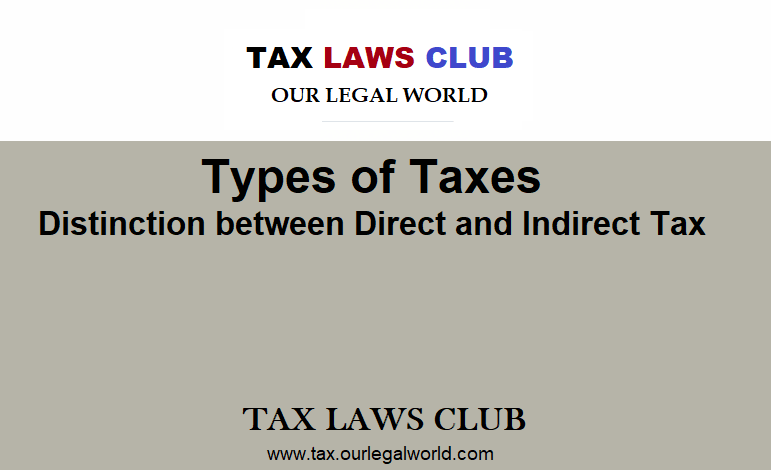Types of taxes and Distinction between Direct and Indirect Tax
Written by Ashish Panday (Advocate)
Introduction
Taxes are financial charges imposed by governments on individuals and businesses to generate revenue for public services and government functions. Taxes can be broadly categorized into two main types: direct taxes and indirect taxes. Here’s a brief overview of each, along with the distinction between them:
Also Read: Career In Customs Law Practice In India
1. Direct Taxes: Direct taxes are levied directly on individuals or entities and are generally based on their income, wealth, or assets. These taxes are typically considered progressive, meaning that as a person’s income or wealth increases, the tax rate also increases. Common examples of direct taxes include:
a. Income Tax: This is a tax on an individual’s or business’s income. The tax rate typically varies based on the level of income, with higher-income earners paying a higher percentage of their income in taxes.
b. Corporate Tax: Corporations pay taxes on their profits, which are considered a form of income.
Corporate tax policy can vary significantly from one country to another and is subject to political and economic considerations. Changes in corporate tax rates and regulations can have a significant impact on a country’s business environment and its ability to attract investment and promote economic growth. As such, corporate tax is a topic of ongoing debate and reform in many countries
c. Property Tax: This tax is based on the value of real estate properties, such as homes and land, and is typically paid by property owners.
d. Wealth Tax: Some countries impose taxes on an individual’s net wealth or assets, including real estate, investments, and other assets.
e. Inheritance Tax: Inheritance taxes are levied on the value of assets transferred to heirs upon the death of an individual.
2. Indirect Taxes: Indirect taxes, on the other hand, are not levied directly on individuals or businesses but are instead imposed on the consumption of goods and services. These taxes are often considered regressive because they tend to have a more significant impact on lower-income individuals, as they represent a fixed percentage of the price of the goods or services purchased. Common examples of indirect taxes include:
a. Value Added Tax (VAT) or Goods and Services Tax (GST): These taxes are added to the price of most goods and services at each stage of production and distribution. Consumers ultimately bear the burden of these taxes.
b. Sales Tax: Similar to VAT and GST, sales taxes are added to the purchase price of goods and services but are typically applied at the retail level.
c. Excise Tax: These taxes are levied on specific goods, such as alcohol, tobacco, gasoline, and certain luxury items.
d. Customs Duties: These taxes are imposed on imported goods as they enter a country.
Customs duties play a significant role in international trade and can affect the cost, availability, and competitiveness of imported goods. Importers, exporters, and businesses engaged in international trade must be aware of and comply with customs duties and related regulations to ensure smooth and legal cross-border transactions. Additionally, customs authorities in each country are responsible for enforcing customs duties and ensuring compliance with trade regulations.
Distinction between Direct and Indirect Taxes:
Taxpayer Liability:
- Direct Taxes: Levied directly on individuals or entities, and the taxpayer is responsible for paying them.
- Indirect Taxes: Imposed on the purchase of goods and services and the tax is ultimately paid by consumers when they buy these products.
Progressivity vs. Regressivity:
- Direct Taxes: Generally progressive, with higher-income individuals paying a higher percentage of their income.
- Indirect Taxes: Tend to be regressive, as they have a more significant impact on lower-income individuals, who spend a larger portion of their income on taxable goods and services.
Visibility:
- Direct Taxes: Typically more visible to taxpayers, as they are directly deducted from income or reported on tax returns.
- Indirect Taxes: Often less visible because they are included in the price of goods and services, making them less apparent to consumers.
Both types of taxes play essential roles in a country’s fiscal policy, and the specific tax system varies from one country to another based on economic and social goals.

